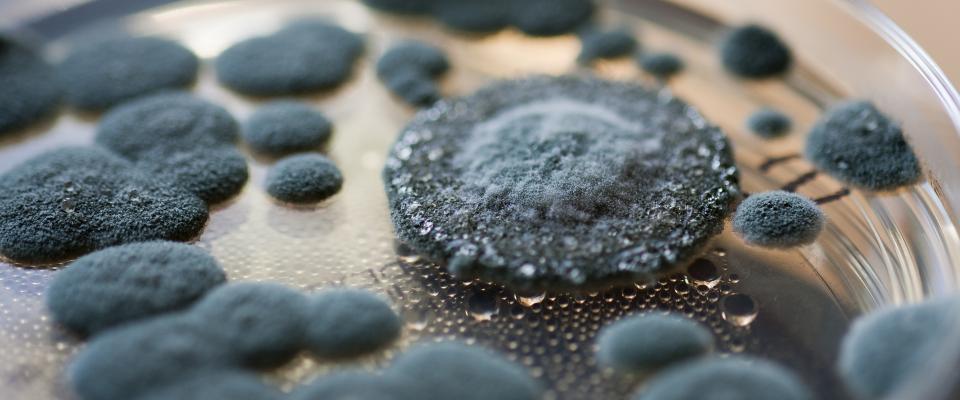Moulds are microorganisms that can grow on virtually any substance, indoor and outdoor, as long as moisture, oxygen, and an organic source are present. In nature, moulds play an important role in breaking down organic matter, like fallen leaves, plants and dead animals. But in our workplaces, moulds can be a significant health hazard.
There are over 100,000 mould species in the world, and about 1,000 species commonly found in Canada.
How do moulds affect the health of workers?
Moulds produce thousands of tiny particles called spores as part of their reproductive cycle. When disturbed by air movement or contact, moulds release these spores into the air. The inhalation of spores, moulds or mould fragments can affect your health or make certain health conditions worse.
Lack of moisture causes moulds to become dormant. Dormant moulds still have the capacity to spread spores and fragments into the air and can become active again when moisture returns.
Some moulds create and release mycotoxins, which slowly wear down the immune system and can lead to allergic or respiratory problems. Workers exposed to mould can have different symptoms. Some may have no reaction at all. The most common effects of mould exposure are:
- Irritation to the skin, eyes, nose, throat
- Burning in the nose, nosebleeds
- Difficulty breathing, asthmatic attacks
- Watery eyes and runny nose
- Nausea
- Headaches
- Fatigue
- difficulty concentrating
- Impairment of the immune system
In some cases, lung and liver cancer can result from long-term exposure to aflatoxin, a toxic compound produced by certain moulds.
People with weakened immune systems are particularly susceptible to mould-related illnesses and should avoid being exposed to it whenever possible.
How are mould hazards identified?
A moulds hazard survey can be done in cooperation with the employer, but the union should approve the survey and be involved in collecting and assessing the information. If the employer resists the idea or denies the existence of mould, the union should conduct its own hazard survey.
Visual inspections are the most reliable method of identifying mould problems. When conducting a visual inspection, look for signs of water damage such as discoloration and staining. Be sure to inspect:
- carpeting and floor covers
- fabric on and underneath furniture
- ceiling tiles and drywall
- behind furniture
- areas where there is standing water, like sinks, kitchens, air conditioners, etc.
Moulds can appear as dark spots or patches of any colour. They can have a variety of textures from woolly to slimy. They thrive in dark, moist environments, so they may be hidden from view. Dormant moulds often have a dry, powdery or crusty appearance.
Air sampling, surface sampling and bulk sampling (taking bits of drywall, flooring, etc.) are also used to identify moulds. The person taking samples must be properly trained and wear appropriate personal protective equipment.
How to prevent moulds from forming in your workplace
It is your employer’s responsibility to provide you with a healthy and safe workplace. Part of this duty is to ensure that all workers are protected from the health risks of mould. Mould hazards often arise as a result of cutbacks or employer neglect.
The following can help prevent mould growth in your workplace:
- Keep relative humidity in the workplace between 30 and 60 per cent.
- Conduct regular inspections and be diligent, particularly if you work in a sewage treatment plant or composting facility.
- Make sure landscaping and eaves trough downspouts direct water away from buildings.
- Ensure any high moisture areas are properly ventilated with local exhaust ventilation that captures the moisture and directs it out of the building.
- Get the employer to insulate cold surfaces to prevent condensation on pipes, windows, walls, roofs and floors.
- Perform regular maintenance and cleaning of heating, ventilation and air conditioning systems.
- Perform regular maintenance of buildings, especially roofs, basements and other locations where there are leaks.
- Ensure proper staffing to conduct maintenance procedures, such as fixing and maintaining plumbing systems and fixing building leaks to prevent mould growth and other workplace hazards.
Most Canadian jurisdictions have a “general duty provision” in their occupational health and safety legislation requiring employers to take all reasonable precautions to protect the health and safety of employees, which includes protecting them from mould hazards. PSAC recommends that members negotiate contract language for specific controls, monitoring and access to information about moulds.
What should you do if there is mould in your workplace?
If you discover mould in your workplace, you should report it to management immediately. If the problem is not immediately rectified, report it to your health and safety committee, so that they can assist until the problem is fixed.
Fixing a mould problem includes identifying and correcting the conditions that allow mould to grow and the safe removal of materials damaged by mould. Appropriate personal protective equipment should be used when doing this. The cleaning and removal process depends on the size and type of mould growth, the extent of the damage, and the location.
Trained professionals should work on removing the mould. In workplaces where staff are expected to participate in mould removal, workers must be properly trained in mould remediation and the hazards associated with working around mould. Staff should be provided with appropriate personal protective equipment. If your employer refuses to deal with mould, you may need to exercise your right to refuse work to protect your own health.
 Member Login
Member Login



